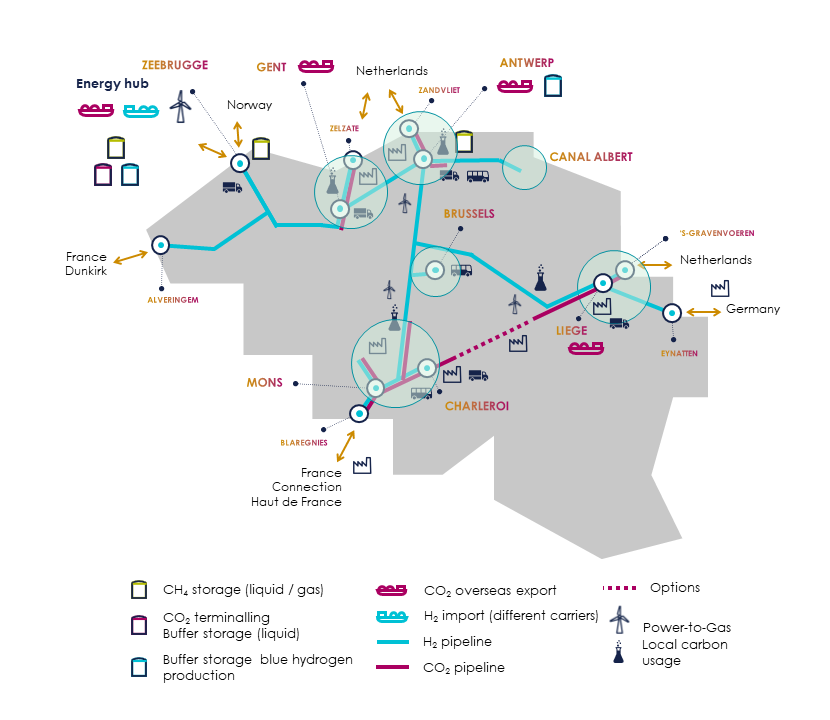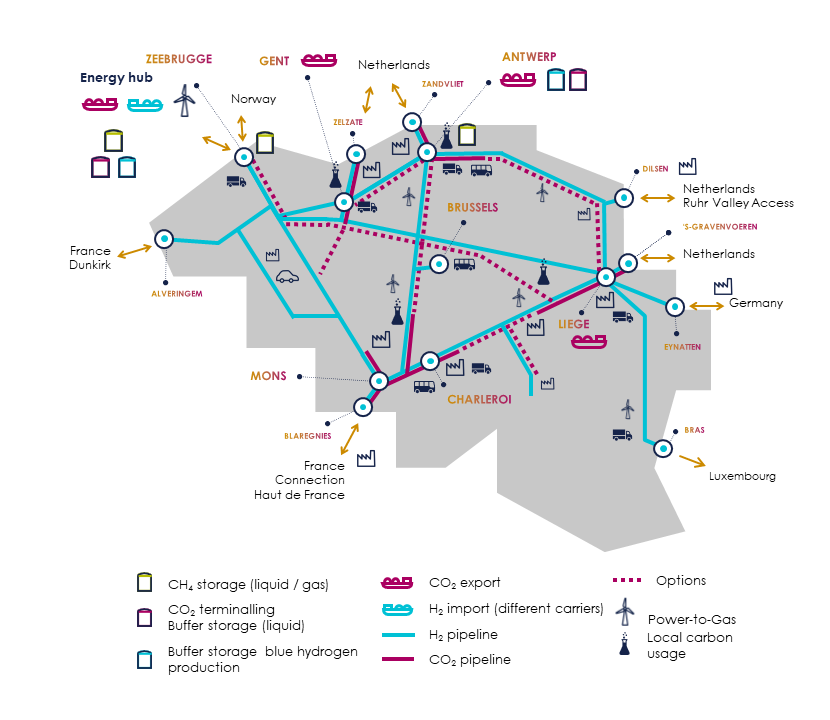Infosession 26/01/2021
Potential users of the hydrogen and carbon infrastructure were invited to our info session on 26/01/2021. During the session we broadly outlined our approach, the commercial process and the technical orientations.
Download the infosession presentation (PDF 1MB)
See the recording of the infosession
Download the Q&A of the infosession (PDF 216KB)
Download the quality specification proposals for hydrogen and CO2 (PDF 128KB)
![]()
Ready to build
Fluxys is ready to build the gas network of the future. Our plan is to progressively prepare our natural gas network in Belgium into complementary systems. They will flow three kinds of molecules indispensable for making the energy transition a success:
- a system for transporting methane (in which biomethane and synthetic methane will increasingly replace quantities of natural gas),
- a system for transporting hydrogen (H2),
- and a system for transporting carbon (CO2).
As we make the gas system accommodate carbon-neutral energy carriers and the circular use of captured carbon, we unlock new solutions for the industry in its efforts to achieve sustainable recovery and growth.

Short-term options to offer first minimum infrastructure enabling decarbonisation
- Development starting from industrial clusters
- Mix of repurposed natural gas pipelines and new infrastructure
- Progressive development of inter-cluster connections: enable transfers, ensure market liquidity, increase security of supply and flexibility
- Development of interconnections with adjacent networks
- Enable green renewable energy upscaling: further development of role Zeebrugge as energy entry gate
- Enable economy of scale of carbon capture and usage/storage activities through local CO2 networks

Progressive long-term development into a full-fledged carbon-neutral system
- Additional inter-cluster connections, increasing flexibility and liquidity
- Additional interconnections with adjacent systems for security of supply and access to a large market
- Import of green hydrogen produced far away via Zeebrugge terminal energy hub
- Alternative carbon capture and usage/storage routes for hard-to-abate industry
Step-wise approach
 |
1. Local clusters: It is our ambition to make hydrogen and carbon infrastructure operational as from 2025 through close collaboration with industry, market players and neighbouring operators. We see it start with developing local clusters in the industrial areas of Antwerp, Brussels, Charleroi/Mons, Ghent, Liège, the Canal Albert and Zeebrugge. |
 |
2. Connecting clusters: Between these local industrial clusters a hydrogen and carbon backbone infrastructure is to develop allowing transfers between them so as to increase market size and improve security of supply. The hydrogen backbone also enables the wide deployment of hydrogen refuelling stations required to decarbonise mobility. |
 |
3. Mature backbone: The hydrogen and carbon clusters and backbone development is also progressively complemented with multiple interconnections with neighbouring systems. For hydrogen this means that customers can rely on a growing European hydrogen market and have access to green hydrogen produced far away within the shortest possible period. |
As other gas transmission system operators develop hydrogen backbones as well, the hydrogen infrastructure in Belgium will reinforce the country’s role at the centre of the North-Western energy system. Fluxys in this respect has mapped out a plan with 10 other gas transmission system operators for a dedicated hydrogen transport system across Europe.

Carbon emissions in Belgium for almost 40% originate from industry, either through energy use or process emissions. As large industrial companies are directly connected into the Fluxys network, reconfiguring this infrastructure offers a cost-efficient solution to make industry’s carbon emissions go down and thus making a key contribution to achieving the 2030 and 2050 climate targets for Belgium and its regions.
Industrial processes for which electricity is not an option – A range of industrial processes requires high temperature heat for which (carbon-neutral) electricity is not an option. Connecting these industries into hydrogen supply enables them to switch to a carbon-neutral alternative. The same goes for industry using carbon-intensive feedstock.
Industrial processes inherently generating carbon emissions – Carbon capture and re-use/storage is considered to be a key technology for reducing carbon emissions and creating clusters for circular re-use of carbon in the production of e.g. carbon-neutral biofuels. The technology is especially important for hard-to-abate sectors with processes inherently generating carbon emissions. Offering transport of captured carbon to destinations of re-use or storage is key to this solution.
- Enquiries on our plan to provide hydrogen and carbon infrastructure for Belgium?
- Don’t hesitate to reach out to :